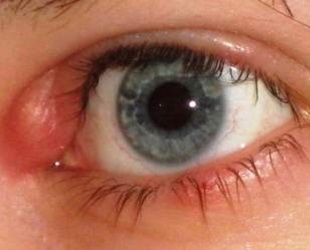
So, on the century there was a bump. It can be painful or not at all to cause unpleasant sensations.
In this case, it will be located on the line of growth of the eyelashes, or it can swell from its inner side, on the conjunctiva, look almost imperceptible or create a strong discomfort in its size.
How to be and what to do first of all, so as not to harm?
In order to determine the tactics of the fight, you will first have to find out what caused it to appear. Read more in more detail.
- 1. Barley
- 2. Halyazion
- 3. Xantelism
- 4. Patching
- 5. Furuncle
- 6. Papilloma
- 7. Results of
- 8. Video
Barley
Improper treatment can only aggravate the problem, and inin some cases - threatens health and even life. Therefore, let's talk about the diseases that cause cones on the eyelids, and how to treat these diseases.
Barley is difficult to confuse with something - a characteristic small abscess, filled with a yellowish secret, the size and shape resembles a barley grain.
In case of inflammation of the sebaceous gland at the root of the eyelash, the outer barley is formed if one of the meybomic glands located outside the eyelid, which secures the eyeball lubricant, is internal.
Provoke the disease of a problem with immunity, hypothermia, stress. Her first symptoms are itching, lacrimation, swelling of the eyelid and redness of the conjunctiva, sensation of a mote in the eye and thread.
A few days later, the abscess formed on the site of the affected gland is opened. And getting pus on the conjunctiva mucosa and cornea with the breakthrough of internal barley can lead to complications in the form of various inflammatory diseases.
In the treatment of barley, ophthalmic ointments are used, for example, Levomecol, and antibiotic drops, such as Gentamicin and Albucid, as well as anti-inflammatory drugs. Of the folk remedies are widely known broth chamomile and tansy flowers.
Timely initiation of treatment will help to avoid the development of an abscess or to speed up the process of its breakthrough and healing of the wound formed.
In no case should you apply compresses and warming in barley - a warm moist environment is favorable for the development of disease causing Staphylococcus aureus.
If barley is not opened within two weeks, you should consult a doctor for surgical removal.
Halyazion
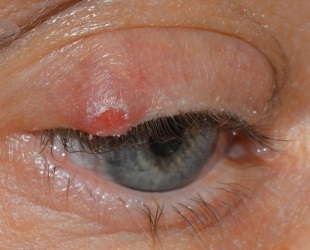
Like barley, haljazion has a spoken name: in translation from Ancient Greek it means "hailstone".In Russian it is often called cold barley.
This is a slowly growing, painless dense cone resulting from the obstruction of the meibomian duct, most commonly seen in people with chronic blepharitis or conjunctivitis, and as a complication of the transferred barley.
A fatty secret can not go out naturally, which leads to the formation of a cyst. In the early stages of development, it practically does not cause inconveniences, except cosmetic.
But over time, it leads to the development of a number of complications: the drying out of the eye due to the unevenness of the eyelids, astigmatism arising from the constant pressure on the cornea, purulent inflammation and fistula. Occasionally haljazion resolves itself, but more often without treatment it does not work out.
With a small amount of cysts, it is treated with heating, drops and ointments containing antibacterial agents, anti-inflammatory drugs, with larger cones injecting corticosteroids directly into the cyst cavity.
Older haljazion is treated surgically, its removal is a simple operation that is performed under local anesthesia.
Externally with haljazionom very similar oncological diseases, such as adenocarcinoma of the sebaceous gland.
Therefore, in some cases, especially patients older than forty, a biopsy of the tumor tissue may be necessary.
Xantelism
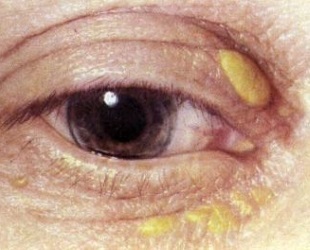
The flattened yellowish plaque fixedly soldered to the underlying tissues and not causing pain and discomfort is xantelasm. Such a swelling can appear not only in the century and is usually surrounded by several more of the same.
Most elderly women with metabolic disorders suffer from xantelasms. Diabetes mellitus, obesity, hypercholesterolemia entail their appearance.
There are no separate methods for getting rid of xantelasm. Surgical removal is possible, but does not prevent the formation of new plaques.
In order for them to dissolve naturally and no longer occur, treatment of existing problems with lipid metabolism is necessary.
Porridge
Another, along with barley disease, characteristic of which is its name. A prosyanka, also known as a millium, is a tight white ball under the skin, usually not exceeding a millet seed, but sometimes reaching the size of a wheat grain.
By its origin, it is close to haljazion, representing a sebaceous gland cyst, and can appear not only in the century, its favorite localization is the skin of the cheeks.
Millions are usually harmless. Their treatment is not an ophthalmologist, but a dermatologist. Removing the existing teddies in the doctor's office does not require anesthesia and takes no more than a couple of minutes.
Proper nutrition, from which too fatty foods are excluded, careful personal hygiene and the use of cosmetics to exfoliate dead skin cells will help get rid of old millions and prevent the emergence of new ones.
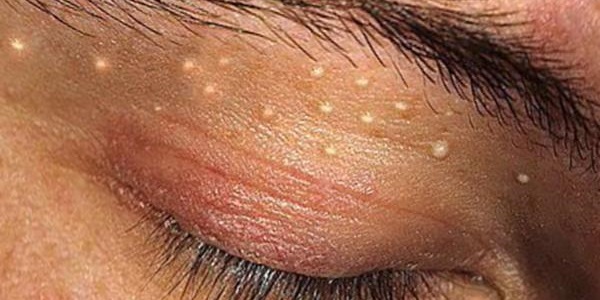
Furuncle
Of all the common diseases of the eyelids, which are manifested by cones, this is the most dangerous. Purulent-necrotic process in hair follicles and sebaceous glands, passing to adjacent tissues, is not necessarily localized in the eyelid region, but sometimes it appears there.
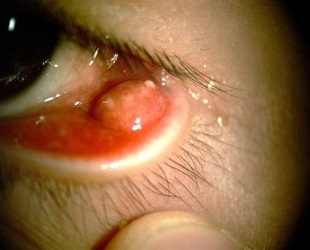
More often furuncles affect the upper eyelid closer to the eyebrow, where there are visible hairs on the skin, much less often - the line of growth of the eyelashes.
Most often, the appearance of a furuncle provokes stress, colds and hypothermia - all those factors that adversely affect immunity. Development of it begins with the appearance of painful swelling, rubbing in the eye, reddening of the century.
To the first signs of inflammation fast swelling of the periorbital tissues or the entire half of the face is quickly associated, as well as general deterioration in physical condition: fever, headaches, weakness.
After a few days, the abscess is opened, and purulent-necrotic masses emerge from it. In its place remains a crater-like wound, filled with remnants of dead tissue. After her healing, a scar remains.
If you suspect a boil, do not attempt to treat it yourself, but immediately consult a doctor. In no case can not squeeze it out - if the pus comes into the orbit, it is fraught with damage to the eyeball and brain.
The development of the furuncle is as follows:
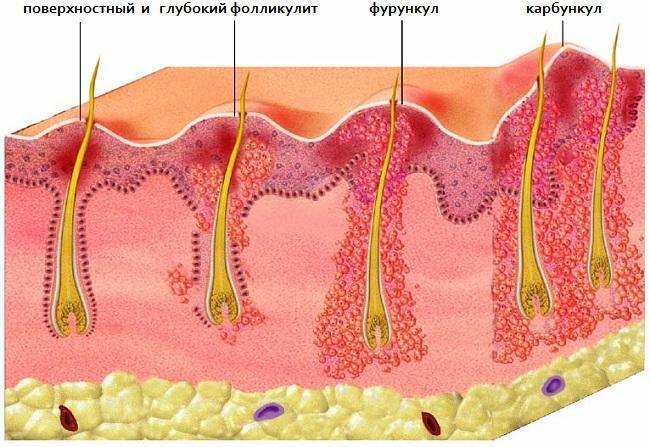
For the treatment of boils apply a broad spectrum of antibiotics, dry heat, anti-inflammatory, if necessary, pain killers and antipyretic drugs.
In some cases, surgical dissection of the abscess and excision of dead tissue are required.
Papilloma
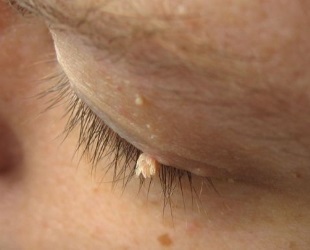
Malignant benign tumors caused by HPV( human papillomavirus) are most often formed in areas with thin, delicate skin, which include eyelids.
Fleshy, with uneven surface accretions on a thin stalk usually form in the corners of the eyes and near the line of the eyelashes. They are painless, but because of their unpleasant appearance they often become a serious aesthetic problem.
The dermatologist deals with the removal of papillomas. They can be withdrawn at home: pharmacies offer a large number of cauterizing and cytotoxic drugs, which are applied directly to the lump and after several applications lead to its necrosis and loss.
However, some strains of HPV cause easily malignant papillomas, so even if they are small and small enough, an analysis should be performed before the treatment to identify the type of virus and determine what to do next.
Some malignant tumors appear similar to simple papillomas, so if the surface of the alleged papilloma is not rough but smooth, it ulcerates and bleeds, an oncologist may need to consult.
Results of
So, we briefly describe the most common causes of cones on the eyelids:
- Painful small abscess in the area of growth of eyelashes or on conjunctiva - barley.
- Painless rounded cyst on the inner side of the eyelid - haljazion.
- Yellowish flat plaque, soldered to surrounding tissues - xanthelas.
- A small white subcutaneous formation is a prosy.
- Painful abscess at the roots of the eyelashes or closer to the line of growth of the eyebrows, accompanied by edema and general deterioration of the state - furuncle.
- Soft swelling on the foot - papilloma.
With proper treatment, they all go without effect. The main thing is not to be diligent in self-medication and not to start the problem because of fear of the hospital or careless attitude towards one's health.
Video
Did you know that?
